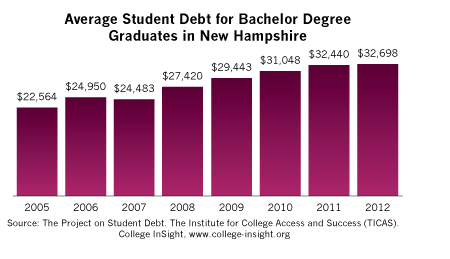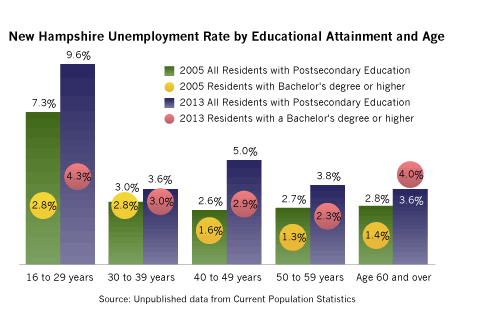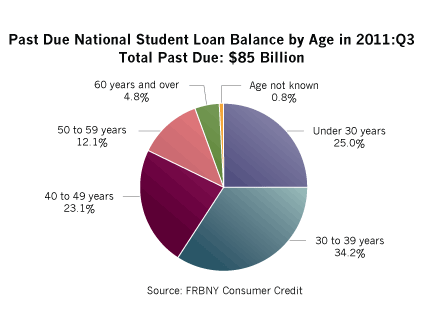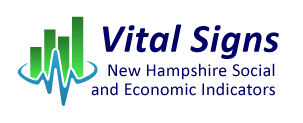Student Debt (print version ![]() )
)
Students receiving a Bachelor’s degree or higher from New Hampshire postsecondary educational institutions in 2012 graduated with an average student debt of $32,698. Among those graduating from a New Hampshire institution, 74 percent had some form of student debt.1 New Hampshire was one of five states with an average student debt above $30,000. There were 15 states with an average student debt of $28,000 or more in 2012; however, these were all within $5,000 of the state with the highest student debt.

In general, student debt has been climbing in all states, especially in the past several years. Factors affecting average student debt levels include state policies, financial aid policies, student demographics, institutional endowments and local cost of living. New Hampshire’s general fund expenditure commitment for higher education was $34.59 per $1,000 of personal income. This was the seventh lowest among all states in 2011. Among the 15 states with an average student debt of $28,000 or more, five others also had low state general expenditure commitments for higher education.2
High student debt has an effect on the overall economy. Timing is everything. Recent graduates are not only finishing their education with higher student debt, but they are also entering a competitive job market. Since the Great Recession, job growth has been slow, and the business climate has made many employers reluctant to increase personnel.
Slow hiring translates to higher unemployment, or possibly underemployment, for new graduates. Among New Hampshire residents age 16 to 29 years, with a Bachelor’s degree or higher, the unemployment rate was one and a half times higher in 2013 than in 2005. Therefore, recent graduates end up with restricted employment prospects and increasingly burdensome student debt.

Student debt does not only belong to young college graduates, but it can also apply to others, such as older individuals who acquired student debt by returning to school, or the parents of younger students. According to a study by the Federal Reserve Bank of New York, the share of total personal debt due to student debt has increased. In third quarter 2011, over nine percent of personal debt was from student debt – higher than both automobile and credit card debt.3

The effect of student debt on different age cohorts can be measured by the two-year default rate of federal student loans, known as “cohort default rates” or CDR.4 A loan is in default after at least 270 days (nine months) of non-payment. In 2002, New Hampshire’s CDR rating was 2.9 percent for all institutions, and in 2011 that figure was 6.0 percent. Defaulting on federally-backed student loans can cause problems for borrowers, such as a negative impact on credit ratings or possible garnishment of income tax refunds. In addition, high student loan debt reduces available income for borrowers to spend in more productive ways, such as purchasing homes or automobiles, or investing for the future.
Anita Josten
1. TICAS/Project on Student Debt. Student Debt and the Class of 2012. projectonstudentdebt.org/files/pub/classof2012.pdf ![]() . Report was a weighted average of nine of fifteen bachelor degree-granting institutions that voluntarily provided the data. Data does not reflect any private loans not accessed through the educational institution. The report does not include for-profit schools. Data only represent graduating students from an institution who started at that institution as first time students, and do not include transfer students. Data is reported for students graduating from New Hampshire institutions regardless of state of residence.
. Report was a weighted average of nine of fifteen bachelor degree-granting institutions that voluntarily provided the data. Data does not reflect any private loans not accessed through the educational institution. The report does not include for-profit schools. Data only represent graduating students from an institution who started at that institution as first time students, and do not include transfer students. Data is reported for students graduating from New Hampshire institutions regardless of state of residence.
2. US Census Bureau. Survey of Local Governments. www.census.gov/govs/ and Bureau of Economic Analysis. Personal Income. www.bea.gov
3. Federal Reserve Bank of New York. Household Debt and Credit: Student Debt. February 28, 2013. Lee, Donghoon. www.newyorkfed.org/newsevents/mediaadvisory/2013/Lee022813.pdf ![]() .
.
4. U.S. Department of Education. ED.Gov. Default Rates Continue to Rise for Federal Student Loans. www.ed.gov/news/press-releases/default-rates-continue-rise-federal-student-loans
![]() Adobe Acrobat Reader format. You can download a free reader from Adobe.
Adobe Acrobat Reader format. You can download a free reader from Adobe.
Translation Resources and Disclaimer
New Hampshire Employment Security (NHES)
45 South Fruit Street | Concord NH 03301 | 603-224-3311 | 1-800-852-3400
TDD Access: Relay NH 1-800-735-2964





